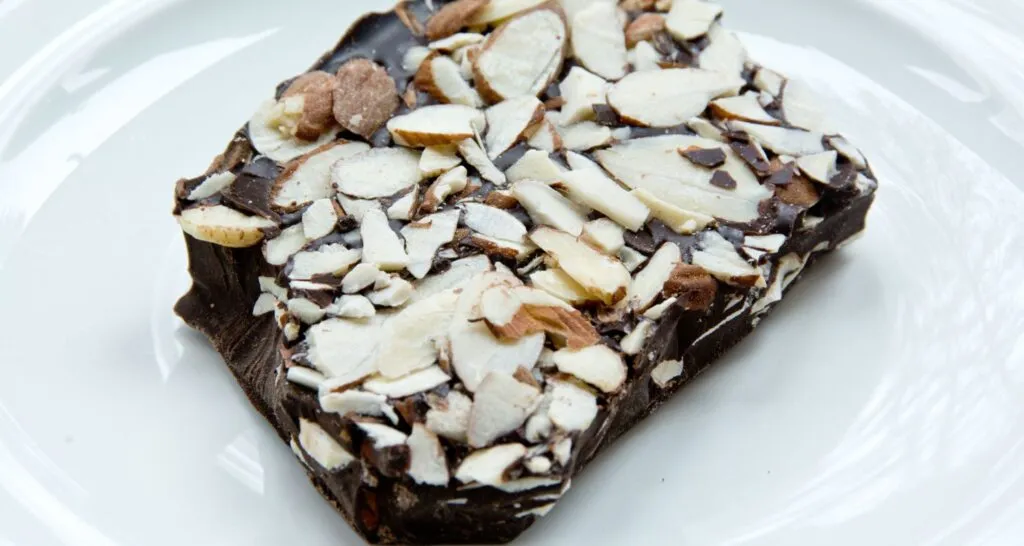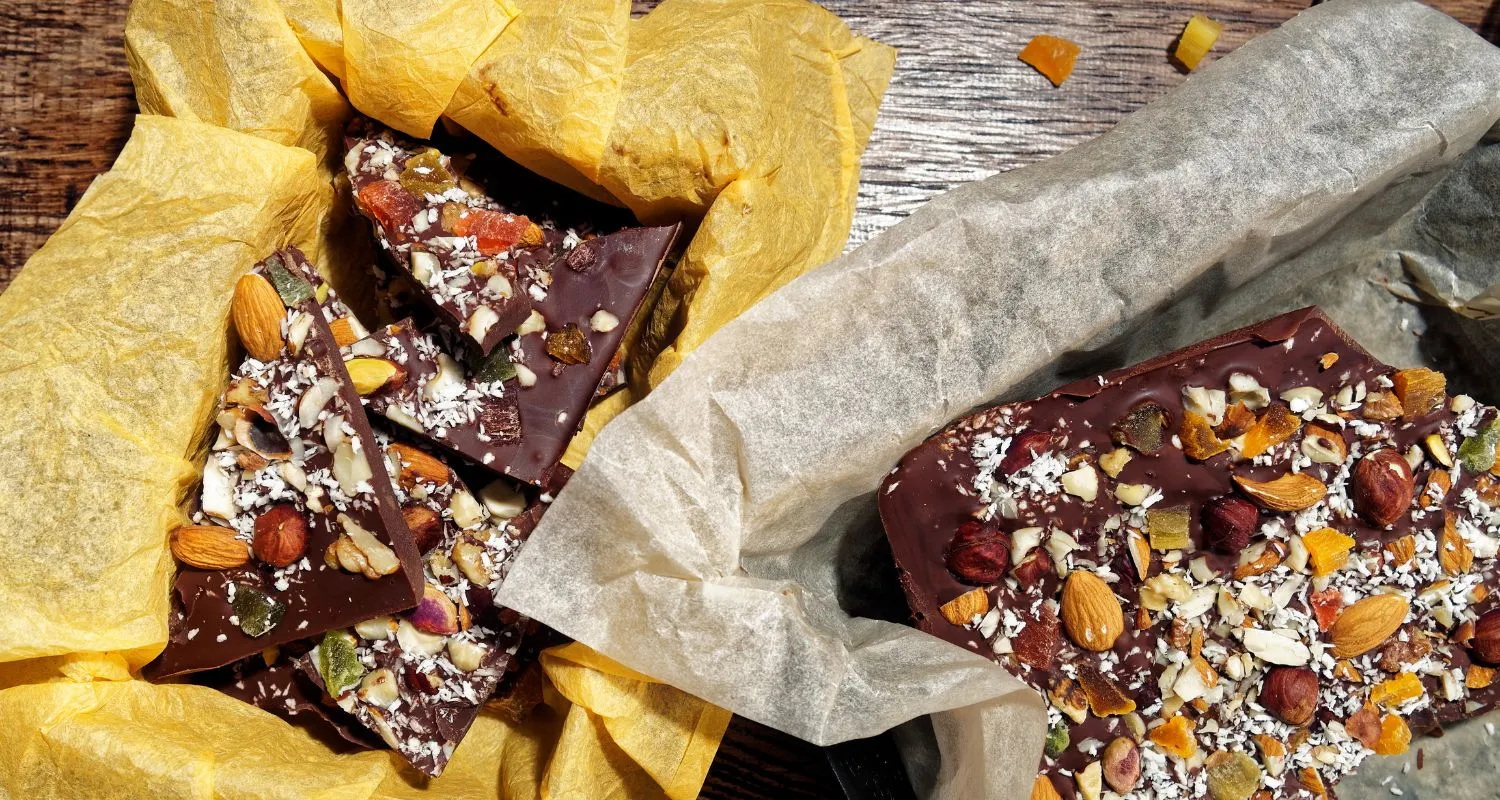Exploring the chocolate world often leads to delightful surprises. Among these, Almond Bark Chocolate shines as a versatile treat loved by many. This article takes you through its journey, covering varieties, health benefits, recipes, and uses. Whether you’re an experienced chef or just starting, get ready to dive into the rich world of almond bark chocolate. Each bite tells a story of taste, tradition, and innovation.
Introduction
What is Almond Bark Chocolate?
Almond Bark Chocolate is a confection that blends almonds’ robust flavors with smooth, rich chocolate. Unlike its name suggests, it’s not tree bark but chocolate with almonds, cooled to form a thin sheet. This simple idea opens up a world of culinary possibilities.
Brief History and Origin
Almond bark chocolate’s journey began with the idea of mixing nuts and chocolate, a centuries-old practice. Its exact origin is unclear, but it grew from the tradition of chocolate bark. This mix has European and American roots, enhancing flavor and adding nutritional value with nuts.
Popularity and Uses in Culinary Arts
Almond bark chocolate is popular worldwide for its versatility and easy preparation. It’s essential for holiday treats, gift baskets, and as a dessert enhancer. Both professional chefs and home cooks use it to explore new flavors, textures, and presentations. It can be a luxurious topping, a key candy ingredient, or a simple snack. Almond bark chocolate adds elegance and indulgence to any dish.
Chocolate and almonds are among the most loved and versatile ingredients. The National Confectioners Association provides insights into chocolate’s history and types, including almond bark. This shows its culinary potential and cultural importance. It’s a favorite in kitchens worldwide.
Next, we’ll explore almond bark chocolate’s types and varieties. We’ll discover what makes it so appealing and how to use it in your cooking
Types and Varieties

Types of Almond Bark
Exploring the world of this delightful treat reveals a wealth of variety. Essentially, it comes in two primary forms: white and dark. Each type presents a unique blend of taste and texture, catering to a wide range of preferences.
- White Chocolate Variant is the sweeter, creamier choice. Its smooth, vanilla-infused essence offers a soft backdrop for the almonds’ crunch. Especially popular during festive seasons, it’s perfect for holiday treats and decorations.
- Dark Chocolate Variant provides a richer taste experience. Its higher cocoa content ensures a fuller, more complex flavor. This version, with its robust taste and almond crunch, appeals to those who favor a less sweet, more nuanced confection.
By adjusting the focus away from the repeated keyphrase and using variations, this revision aims to maintain a natural and engaging flow while addressing the concern of over-optimization
Varieties of Almond Bark Chocolate
The versatility of almond bark chocolate doesn’t stop at its base ingredients. Both homemade and store-bought versions offer a range of flavors and innovations, allowing for endless customization and experimentation.
Homemade vs. Store-Bought:
Making almond bark chocolate at home is special. It’s not just about the treat; it’s about the memories. You control the ingredients and nut-to-chocolate ratio, adding a personal touch. Store-bought almond bark, however, offers quick convenience and consistent quality with various flavors.
Flavor Variations and Innovations:
Adding sea salt can boost sweetness, while dried fruits add flavor layers. For the adventurous, spicy chili, matcha powder, or caramel swirls can turn almond bark into a gourmet treat.
Whether you prefer dark or white chocolate almond bark, its versatility is undeniable. It invites both novice cooks and chefs to experiment, showing that simple mixes can create extraordinary flavors.
Exploring almond bark chocolate’s health benefits next, we see it’s more than a treat. With creativity, it becomes a balanced diet addition. Stay tuned for how it can enhance your healthy lifestyle
Health and Nutrition
Health Benefits of Almond Bark Chocolate
Diving into the world of sweets, it’s a delight to find options that not only please our taste buds but also offer health perks. This chocolate variety, enriched with almonds, is a standout, blending the nutritious benefits of nuts with the antioxidant qualities of cocoa. Let’s explore how this treat is not just tasty but potentially beneficial for our well-being.
Almonds are a powerhouse of nutrition, brimming with healthy fats, fiber, protein, magnesium, and vitamin E. These elements are vital for heart health, blood sugar regulation, and reducing inflammation. Dark chocolate, known for its antioxidants like flavonoids, contributes to heart health and lowers inflammation.
The almonds in this chocolate contribute more than just texture; they bring substantial health benefits. Their high content of monounsaturated fats, fiber, and protein helps maintain fullness, aiding in snack satisfaction without the need for overeating.
Cocoa, especially in dark varieties, has its own set of advantages. It’s recognized for improving circulation, lowering blood pressure, and elevating HDL cholesterol levels. Opting for a version with more cocoa enhances these benefits, offering a healthier indulgence option.
In essence, this chocolate isn’t only a delight to eat but also a friend to your health. With mindful selection and moderation, it’s possible to enjoy its rich taste and reap health rewards.
Dietary Considerations for Almond Bark
Almond bark chocolate is a delightful alternative to traditional sweets, offering a blend of taste and nutrition. However, it’s crucial to navigate dietary restrictions and allergens carefully.
Allergies and Sensitivities: Given that almonds are tree nuts, they pose an allergen risk for some. Also, dairy or soy lecithin in chocolate can trigger sensitivities. Fortunately, alternatives exist, like using seeds or selecting allergen-free chocolate, to enjoy similar treats without the worry.
Vegan and Gluten-Free Choices: For vegans, choosing dairy-free chocolate is essential. Although chocolate and almonds are inherently gluten-free, the risk of cross-contamination is real for those with celiac disease or gluten sensitivity. Always verify product labels to ensure they meet your dietary requirements.
Enjoying almond bark chocolate as part of a balanced diet is possible with attention to portion control and ingredient selection. The Vegan Society provides numerous vegan-friendly recipes, ensuring no compromise on flavor for those with dietary restrictions.
Next, we’ll explore homemade almond bark chocolate, allowing you to customize this treat to fit your dietary preferences perfectly. Look forward to home crafting tips, tricks, and recipes designed to make your almond bark chocolate experience uniquely satisfying
Making Almond Bark Chocolate at Home
Creating Almond Bark Chocolate in your own kitchen is not just about crafting a delicious treat; it’s an invitation to indulge in a bit of culinary creativity. Whether you’re a seasoned chef or someone who’s just beginning to explore the wonders of homemade confections, making almond bark chocolate is a delightful and rewarding experience. Let’s dive into the essentials of whipping up this delectable treat from the comfort of your home.

Ingredients and Equipment Needed
To embark on your almond bark chocolate-making adventure, you’ll need a few key ingredients and some basic kitchen equipment. Here’s what to gather:
- Ingredients:
- High-quality chocolate (dark, milk, or white, depending on your preference)
- Whole almonds (roasted for extra flavor)
- Optional: sea salt, dried fruits, or other nuts for additional flavor and texture
- Equipment:
- Double boiler or microwave-safe bowl (for melting chocolate)
- Baking sheet
- Parchment paper
- Spatula
Step-by-Step Directions:
- Preparation: Begin by lining your baking sheet with parchment paper. This will prevent the chocolate from sticking and make it easier to break the bark into pieces once it’s set.
- Melting the Chocolate: Use a double boiler or microwave to gently melt your chocolate. If using a microwave, heat in short bursts, stirring in between, to avoid burning the chocolate.
- Mixing in the Almonds: Once the chocolate is smoothly melted, stir in your roasted almonds, making sure they’re evenly coated. If you’re feeling adventurous, this is the time to add any extra ingredients like sea salt or dried fruits.
- Spreading the Mixture: Pour the chocolate and almond mixture onto your prepared baking sheet, spreading it out into an even layer with your spatula. Aim for about 1/4 inch thickness for the perfect bite.
- Cooling and Setting: Allow the almond bark to cool at room temperature until solid. For a quicker set, you can place the baking sheet in the refrigerator.
- Breaking into Pieces: Once set, break the bark into pieces by hand or cut with a knife for more uniform shapes.
- Enjoying and Storing: Enjoy your homemade almond bark chocolate as a snack or dessert. Store any leftovers in an airtight container at room temperature or in the refrigerator for longer freshness.
Preparation Tips
- Quality Matters: The quality of chocolate you choose will significantly impact the flavor of your almond bark. Opt for the best you can afford.
- Customization Ideas: Don’t hesitate to get creative with your almond bark. Experiment with different types of nuts, spices, or even a sprinkle of coarse salt to enhance the chocolate’s flavor.
Making almond bark chocolate at home allows you to control the quality of ingredients and tailor the treat to your taste preferences. It’s a simple process that yields delicious results, perfect for sharing with loved ones or enjoying as a personal indulgence.
As we continue to explore the endless possibilities of almond bark chocolate, our next section will unveil creative uses and recipes that showcase this versatile treat in all its glory. Stay tuned for inspiration that will elevate your dessert game to new heights.
Creative Uses and Recipes
Almond bark chocolate, with its delightful crunch and rich flavor, is far more than just a standalone treat. Its versatility makes it a fantastic ingredient for a myriad of creative culinary endeavors. From elegant desserts to casual snacks, the possibilities are as boundless as your imagination. Let’s explore some innovative ways to incorporate almond bark chocolate into your cooking repertoire, along with a couple of standout recipes that are sure to impress.
Creative Ways to Use Almond Bark
- Desserts and Snacks: Transform ordinary desserts into extraordinary treats by drizzling melted almond bark chocolate over cakes, cookies, or fruit. For a quick snack, dip pretzels or marshmallows into melted almond bark and let them set for a fun and easy treat.
- Holiday and Gift Ideas: Homemade almond bark chocolate makes for a thoughtful and personalized gift, especially during the holiday season. Package it in decorative bags or boxes, and you have a delightful present for friends and family. It’s also perfect for creating festive shapes and designs, like chocolate-covered almond Christmas trees or heart-shaped treats for Valentine’s Day.
Featured Recipes
Almond Bark Chocolate Treats
Ingredients:
- 1 pound high-quality chocolate (dark, milk, or white)
- 1 1/2 cups whole roasted almonds
- Optional: sea salt, dried cranberries, or orange zest for extra flavor
Instructions:
- Melt the chocolate in a double boiler or microwave, stirring until smooth.
- Stir in the roasted almonds until they’re fully coated in chocolate.
- Spread the mixture onto a parchment-lined baking sheet, creating an even layer.
- If desired, sprinkle with sea salt, dried cranberries, or orange zest before the chocolate sets.
- Allow the bark to cool and harden, then break into pieces.
- Enjoy as is, or package for gifting.
Incorporating Almond Bark into Baking
Chocolate Swirl Brownies with Almonds:
Ingredients:
- Your preferred brownie mix or homemade batter
- 1 cup melted chocolate bark
- 1/2 cup chopped almonds
Instructions:
- Follow the brownie mix or your recipe to prepare the batter.
- Spread half of this batter into a greased baking pan.
- Drizzle half of the melted chocolate bark over this layer, then scatter the chopped almonds on top.
- Cover with the remaining batter, and finish with a layer of the remaining chocolate bark.
- Swirl the chocolate gently into the batter using a knife.
- Bake as per the brownie instructions.
- Allow to cool, then cut into squares for serving.
These brownies showcase just one way to incorporate chocolate bark into your baking. Its versatility makes it perfect for enhancing desserts or creating simple snacks. Whether you’re aiming for sophistication in your sweets or easy treats, chocolate bark is an excellent choice

As we wrap up this section, remember that the key to great almond bark chocolate treats lies in experimentation and personalization. Don’t be afraid to try new combinations and flavors—the results might just surprise you. Next, we’ll guide you through selecting the best almond bark chocolate and where to find it, ensuring your culinary creations are not only delicious but made with the finest ingredients.
Buying Guide
When it comes to creating delectable treats with Almond Bark Chocolate, the quality of ingredients you choose can make all the difference. Whether you’re planning to indulge in homemade almond bark or use it as a key ingredient in various recipes, knowing how to select the best chocolate and where to find it is crucial. This guide aims to arm you with the knowledge needed to make informed decisions, ensuring your culinary creations are as delicious as they are beautiful.
Choosing the Best
Selecting top-notch almond bark chocolate enhances both snacking and baking experiences. Here’s how to ensure you pick the finest:
Quality of Chocolate
Aim for almond bark crafted from premium chocolate. Ideally, cocoa butter (for white chocolate) or cocoa mass (for dark chocolate) should top the ingredient list. Steer clear of options where sugar dominates or those using vegetable fats over cocoa butter.
Almond Content
Opt for almond bark rich in almonds to enjoy a satisfying crunch and robust flavor. Verify the almond-to-chocolate ratio on the ingredient list to ensure a generous almond presence.
Flavor and Texture
Whenever possible, sample the almond bark prior to purchase. High-quality almond bark should offer a smooth melt in your mouth, with almonds that are fresh and crunchy, achieving a perfect sweet, bitter (in dark chocolate), and nutty flavor balance.
Brand Recommendations
Research and reviews can guide you to the best almond bark chocolate brands. Favor those committed to quality ingredients and ethical sourcing.
Where to Find Your Perfect Almond Bark
- Online Sources: The internet is a treasure trove for chocolate enthusiasts, offering a wide array of almond bark options. Explore chocolatiers’ websites and online marketplaces to find your match, using customer reviews as your guide.
- Local Specialty Stores: Gourmet shops and specialty grocers are great places to discover high-quality almond bark, often featuring products from small-scale producers that bring an artisanal flair.
- Craft and Culinary Supply Stores: For those who prefer a hands-on approach, these stores are ideal for sourcing top-notch melting chocolate and almonds, giving you the tools to craft your own unique almond bark.
Choosing the right almond bark is about finding the perfect balance between quality, flavor, and personal taste. These suggestions aim to guide you to a choice that delights both your palate and elevates your cooking.
As we conclude, remember that delving into the world of almond bark is an adventure in both taste and creativity. Whether you’re making it from scratch or selecting the best store-bought option, the joy comes from the experience and the delicious outcomes. This guide is here to help you navigate the journey to the most enjoyable almond bark experience
FAQs
How do you store almond bark chocolate to ensure freshness?
Keep it in a cool, dry area away from sunlight and odors, ideally between 60-70°F (15-21°C). For longer storage, wrap it well and refrigerate or freeze, allowing it to reach room temperature before unwrapping to avoid moisture.
Are there any dairy-free options available?
Yes, there are options for those avoiding dairy. Look for products labeled as vegan or dairy-free, which use plant-based ingredients. The Vegan Society provides further information on these alternatives.
Is almond bark just chocolate?
No, it’s a confectionery coating resembling chocolate but made from vegetable fats instead of cocoa butter, often used in baking and candy making.
What is the difference between almond bark and chocolate?
The difference is in their composition; almond bark contains vegetable fats, while chocolate includes cocoa butter and chocolate liquor, affecting texture and melting properties.
Is almond bark considered chocolate?
It looks and is used like chocolate but doesn’t contain cocoa butter, making it a vegetable fat-based coating rather than true chocolate.
Is almond bark and white chocolate the same?
No, they differ in composition; almond bark is made with vegetable fats, whereas white chocolate contains cocoa butter, influencing their culinary uses and flavor.
How to melt it in the microwave?
Break it into small pieces, place in a microwave-safe bowl, and heat in short bursts, stirring between each until smooth
